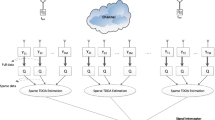Abstract
Acoustic source localization has many important applications particularly for military tracking foreign objects. Even though Wireless Sensor Networks (WSNs) have been developed, this localization problem remains a big challenge. A system for solving source localization must have the ability to deal with the problems of recorded convolved mixture signals while minimizing the high communication and computation cost. This paper introduces a distributed design for positioning multiple independent moving sources based on acoustic signals in which we focus on utilizing the relative information of magnitudes recorded at different sensors. The sensors perform preprocessing on the sensed data to capture the most important information before compressing and sending extracted data to the base. At the base, the data is uncompressed and the source locations are inferred via two clustering stages and an optimization method. Analysis and simulation results lead to the conclusion that our system provides good accuracy and needs neither much communication nor complex computation in a distributed manner. It works well when there exists high noise with Rayleigh multipath fading under Doppler effect and even when the number of independent sources is greater than the number of microphone sensors.
Similar content being viewed by others
References
Arabnia Hamid R (1990) A parallel algorithm for the arbitrary rotation of digitized images using process-and-data-decomposition approach. J Parallel Distrib Comput 10:188–192
Sasaki Y, Kagami S, Mizoguchi H (2006) Multiple sound source mapping for a mobile robot by self-motion triangulation. In: International conference on intelligent robots and systems, IEEE, pp 380–385
Stanacevic Milutin (2005) Micropower gradient flow acoustic localizer. IEEE Trans Circuits Syst 52:2148–2157
Birchfield ST, Gilmor DK (2001) A unifying framework for acoustic localization. In: IEEE international conference, IEEE Comput Soc, Los Alamitos
Mahajana A, Walworth M (2001) 3-d position sensing using the differences in the time-of-flights from a wave source to various receivers. IEEE Trans Robot Autom 17:91–94
Valin J-M, Michaud F, Rouat J, L’etourneau D (2003) Robust sound source localization using a microphone array on a mobile robot. In: Proc ICASSP98, pp 1228–1233
Antonacci F, Riva D, Saiu D, Sarti A, Tagliasacchi M, Tubaro S (2006) Tracking multiple acoustic sources using particle filtering. In: European signal processing conference, EUSIPCO-2006
Kaouri K Left-right ambiguity resolution of a towed array sonar (2000) Ph.D dissertation, M.Sc. in mathematical modelling and scientific computing
Ward DB, Williamson RC (2002) Particle filter beamforming for acoustic source localization in a reverberant environment. In: IEEE international conference on acoustics, speech, and signal processing, IEEE Press, New York
Roman N, Wang DL (2008) Binaural tracking of multiple moving sources. IEEE Trans Speech Audio Process 16:728–739
Gisolf A, Simons DG (2006) Adaptive motion compensation in sonar array processing, 1st edn. Netherlands Organization for Applied Scientific Research (TNO)
Hyvarinen A, Oja E (2000) Independent component analysis: a tutorial. Neural Netw 13:4–5
Mutihac R, Van Hulle MM (2004) Comparison of principal component analysis and independent component analysis for blind source separation. IEEE Trans Speech Audio Process 56:20–32
Smaragdis P (1998) Blind separation of convolved mixtures in the frequency domain. Neurocomputing 22:21–34
Lambert RH (1996) Multichannel blind deconvolution: Fir matrix algebra and separation of multipath mixtures. Ph.D. dissertation, University of Southern California, EE Dept
Dang V-H, Le-Tien T, Lee Y-K, Lee SY (2010) Acoustic multiple object positioning system. In: International symposium on performance evaluation of wireless ad hoc, sensor, and ubiquitous networks, PE-WASUN-2010. ACM, New York
Ciaramella A, Tagliaferri R (2006) Separation of convolved mixtures in frequency domain ica. Int Math Forum 16:769–795
Birchfield ST, Gilmor DK (2002) Fast Bayesian acoustic localization. In: IEEE international conference on acoustics, speech, and signal processing, IEEE Press, New York
Serway R, Beichner R (1999) Physics for scientists and engineers, 5 edn. Brooks/Cole, Pacific Grove
Haddad RA, Parsons TW (1991) Digital signal processing theory, applications and hardware. Computer Science Press, New York
Van Den Enden AWM, Verhoeckx NAM (1989) Discrete-time signal processing: an introduction, 1 edn. Prentice Hall, New York
Wismer DA, Chattergy R (1979) Introduction to nonlinear optimization. North-Holland, Amsterdam
Van Trier J Some nonlinear optimization methods (http://sepwww.stanford.edu/public/docs/sep51/)
Duda RO, Hart PE, Stork DG (2001) Pattern Classification., 2nd edn. Wiley, New York
Dang V-H Generated examples of multi-object sound data (http://uclab.khu.ac.kr/ext/dvhung/)
Young DJ, Beaulieu NC (2000) The generation of correlated Rayleigh random variates by inverses discrete Fourier transform. IEEE Trans Commun 48:1114–1127
Author information
Authors and Affiliations
Corresponding author
Rights and permissions
About this article
Cite this article
Dang, VH., Lee, S. & Lee, YK. A distributed design for multiple moving source positioning. J Supercomput 61, 438–462 (2012). https://doi.org/10.1007/s11227-011-0600-x
Published:
Issue Date:
DOI: https://doi.org/10.1007/s11227-011-0600-x




